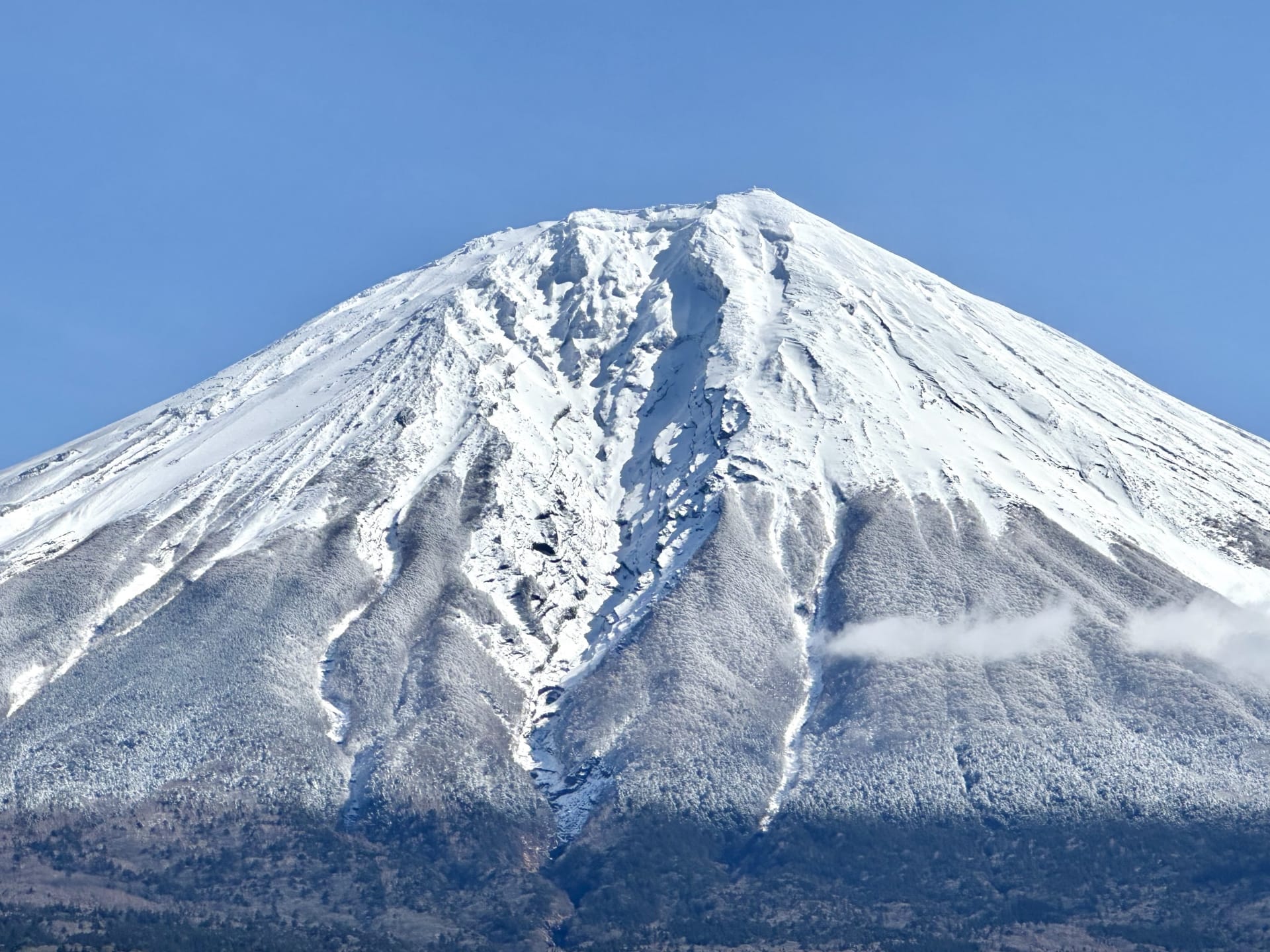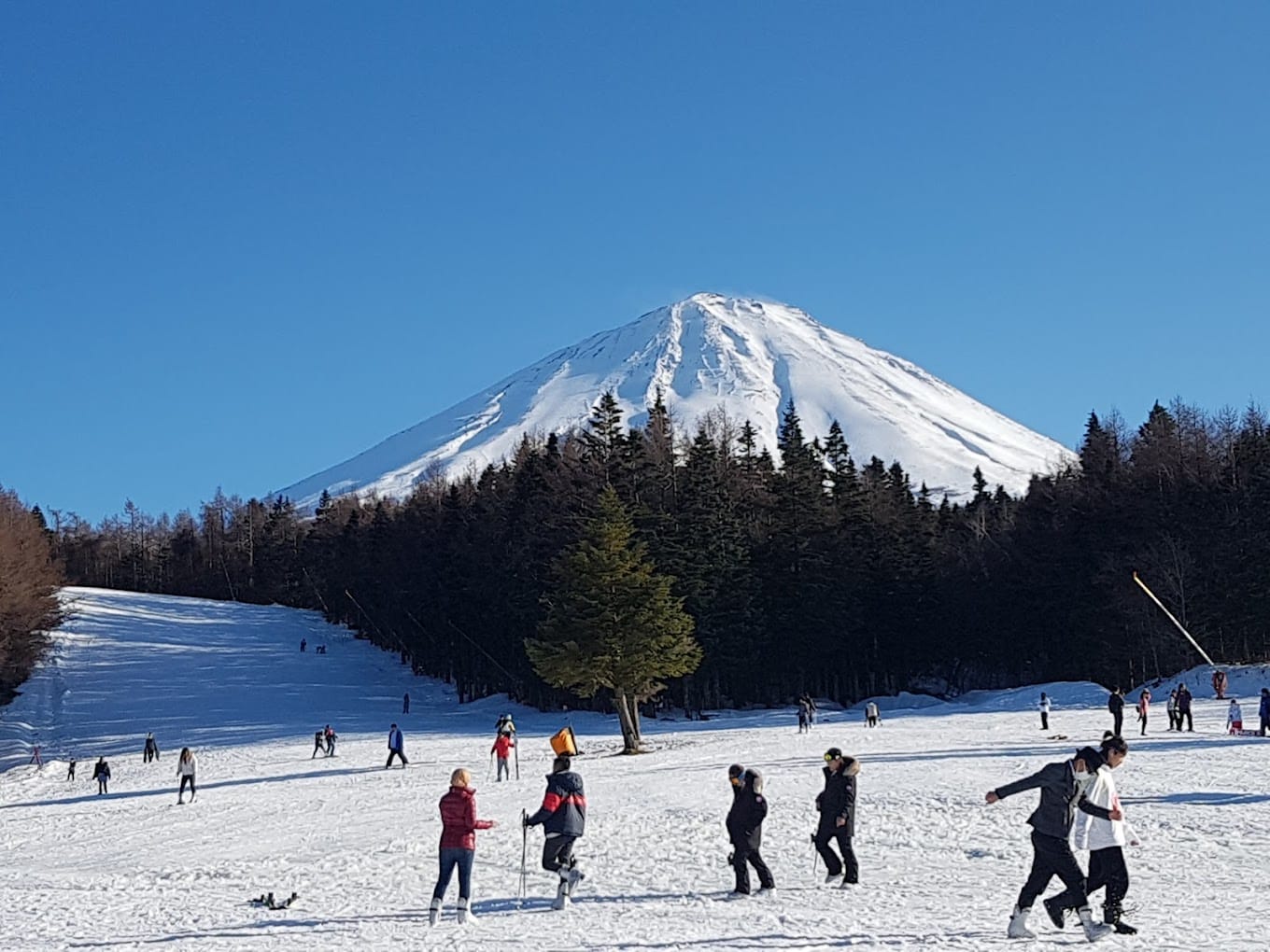A Guide to Enjoying Mt. Fuji in Winter for Foreign Tourists 2025 w/map
Mount Fuji, a symbol of Japan, attracts countless tourists who visit Japan specifically to witness its majestic presence. However, given Mount Fuji's massive size and the numerous tourist attractions scattered around its vicinity, we've created this guide to help you explore the Mount Fuji area efficiently.
Additionally, Magical Trip, which won the #1 spot for all tours on Tripadvisor in 2024, has recently launched the Mount Fuji tours.

The "Mt. Fuji Full-day Nature Guided Tour with a Private Chartered Car & Guide" offers a stress-free experience exploring the Mount Fuji area, complete with private car transportation from Tokyo.
Even if you have limited time to explore the Mount Fuji region, this tour allows you to visit all the must-see spots with detailed guidance from your tour guide.
If you're interested in efficiently experiencing the essential locations while gaining deep insights from a knowledgeable local guide who knows the area inside and out, we highly recommend joining the "Mt. Fuji Full-day Nature Guided Tour with a Private Chartered Car & Guide."
Introduction
I feel that Mt. Fuji in winter shows a different face from its lively summer climbing season. The sight of Mt. Fuji covered in pure white snow evokes a sense of divinity, and even for me as a Japanese person, it's a special view.
On clear days, Mt. Fuji stands proudly against the crystal-clear blue sky. At dusk, we see Diamond Fuji. In the starlit sky, the mountain emerges as a silver world. Around the Fuji Five Lakes, numerous winter-only spectacular views await, such as the inverted reflection of Mt. Fuji on the water surface, ice falls, and frost-covered trees.
Of course, Mt. Fuji in midwinter is extremely cold, and climbing involves risks. However, there are other ways to enjoy winter - savoring hot pot dishes while viewing magnificent Mt. Fuji from the lakeside, or taking a snowshoe walk through the snow-covered forest.
In this article, I'll share plenty of Mt. Fuji's winter charms with our foreign visitors.
From Tokyo access routes to sightseeing spots, activities, and dining information, it's packed with useful tips. I'll provide lots of information that only locals who frequent Mt. Fuji would know, so please use this as your reference.
Table of Contents
・The Appeal of Mt. Fuji in Winter
・How to Access Mt. Fuji from Tokyo
・Winter Viewpoints of Mt. Fuji
・Winter Events and Activities Around the Fuji Five Lakes
・Winter Cuisine Around Mt. Fuji
・Frequently Asked Questions About Mt. Fuji in Winter
The Appeal of Mt. Fuji in Winter
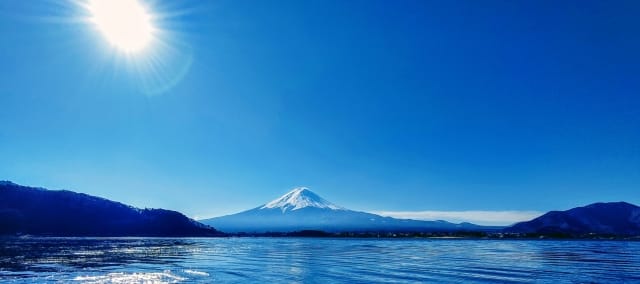
Mt. Fuji in winter shows a different, fantastical beauty compared to summer.
On clear days, the contrast between the snow-covered Mt. Fuji and the crystal-clear blue sky stretching to the summit creates a spectacular view. At dusk, you'll be breathtaking at the divine sight of the snow scenery illuminated by the sunset and the phenomenon known as Diamond Fuji.
At the foot of the mountain, frost-covered trees and frozen waterfalls sparkle in the sunlight, creating mystical scenery. At night, the collaboration between the starry sky and snow-covered Mt. Fuji is overwhelmingly impressive.
While Mt. Fuji is very cold in winter and not suitable for climbing, I think winter is actually the best season in terms of scenery. Why not enjoy Mt. Fuji's winter beauty in ways other than climbing?
How to Access Mt. Fuji from Tokyo

You can access Mt. Fuji from Tokyo by either train or bus. I'll introduce the characteristics of each method.
Access by Train
When using the train, take the JR Chuo Line from Shinjuku to Otsuki, then transfer to the Fujikyu Railway Line. From Otsuki, you can go directly to Lake Kawaguchiko, Fujiyoshida, or Mt. Fuji Station at the mountain's base.
The view from the train window is magnificent, especially after transferring to the Fujikyu Railway Line from Otsuki, where you can enjoy the journey while taking in Mt. Fuji's majestic scenery. The journey from Shinjuku to Lake Kawaguchiko takes about 2.5 hours.
Access by Bus
When using the bus, direct buses from Tokyo Station or Shinjuku Station to the Fuji Five Lakes area are convenient. Fuji Kyuko Bus and JR Bus operate services, and the fares are more reasonable than the train. It's great that you can safely transport lots of luggage.
While you can't expect much scenery along the way as buses mainly use the Chuo Expressway, you'll arrive in the Mt. Fuji area in about 2.5 to 3 hours if there's no traffic. I recommend the bus for those who want easy access or have lots of luggage.
If you want to save the hassle of taking public transportations, try the "Mt. Fuji Full-day Nature Guided Tour with a Private Chartered Car" which comes with a driver and guide.
This includes round-trip transportation from Tokyo, and an experienced guide who will take you to carefully selected must-see spots around Mount Fuji.
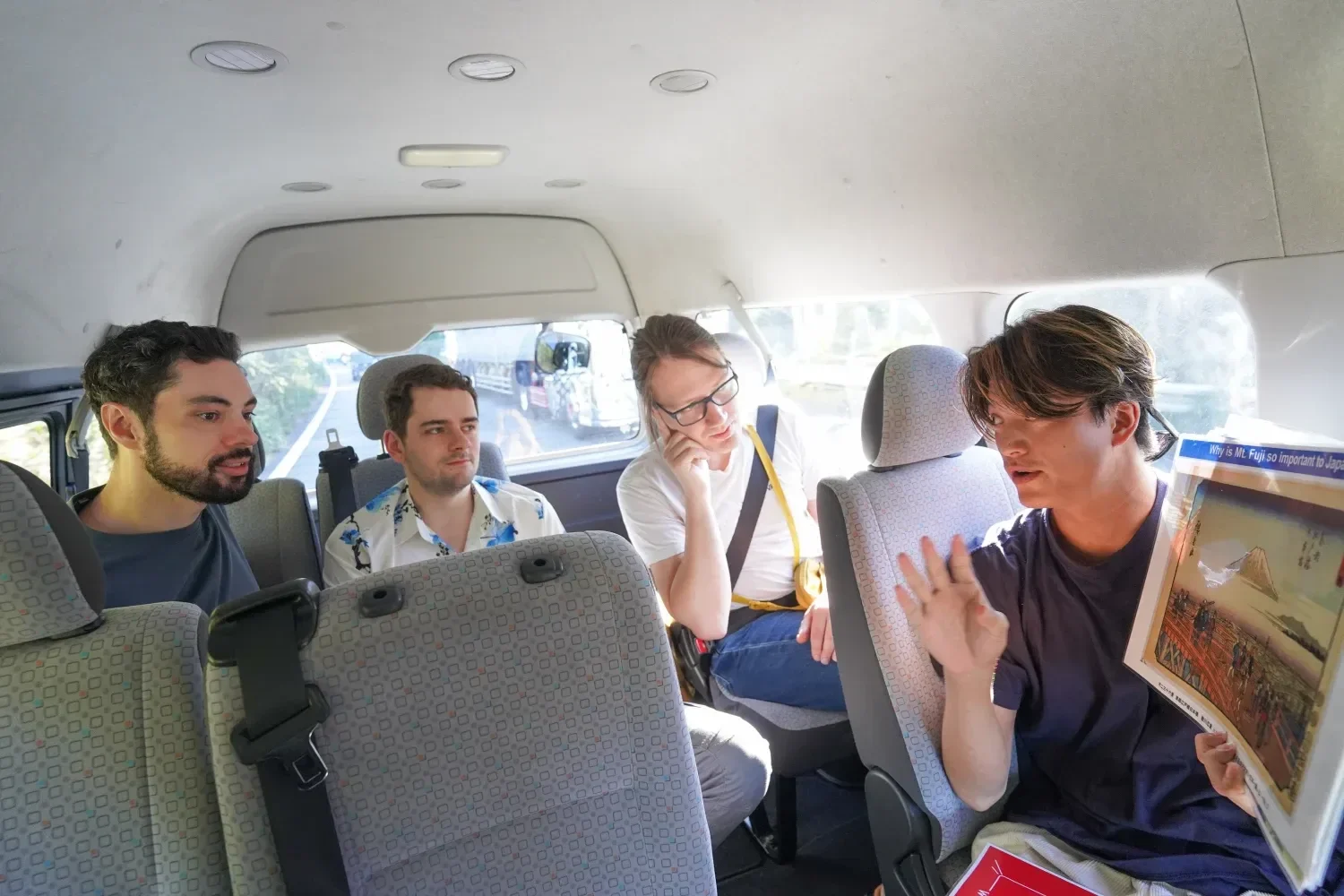
Winter Viewpoints of Mt. Fuji
I recommend the Fuji Five Lakes for viewing Mt. Fuji in winter. Not only can you see Mt. Fuji reflected in the lakes like mirrors, but you can also enjoy the unique natural scenery around the lakeshores. There are many power spots and collaboration spots with Mt. Fuji, so I'll introduce several of them.
Fuji Five Lakes
Lake Kawaguchiko
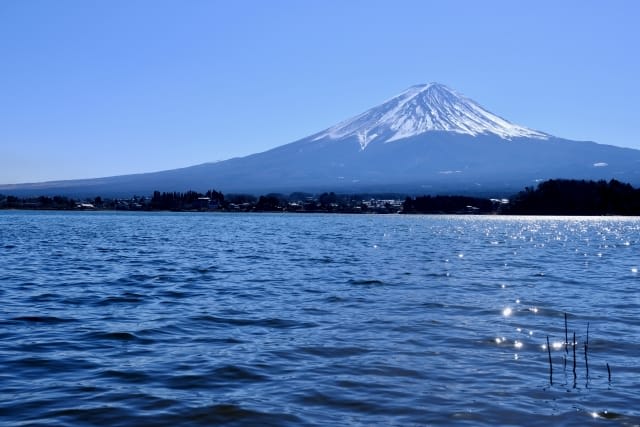
Winter at Lake Kawaguchiko offers an impressive collaboration between the majestic Mt. Fuji and its reflection on the lake surface. Especially, the inverted image of Mt. Fuji wrapped in morning mist is fantastical, with an otherworldly beauty. I've visited Lake Kawaguchiko early in the morning many times just to see this mystical scene.
I recommend taking a walk along the lakeshore during the day. Walking along the silver lakeside with snow-covered Mt. Fuji in the background will help you forget the daily hustle and bustle.
At dusk, you'll be enchanted by Diamond Fuji, where the sunset and Mt. Fuji's silhouette create a magical scene. Lake Kawaguchiko is a must-visit spot if you want to fully appreciate Mt. Fuji in winter.
Lake Saiko
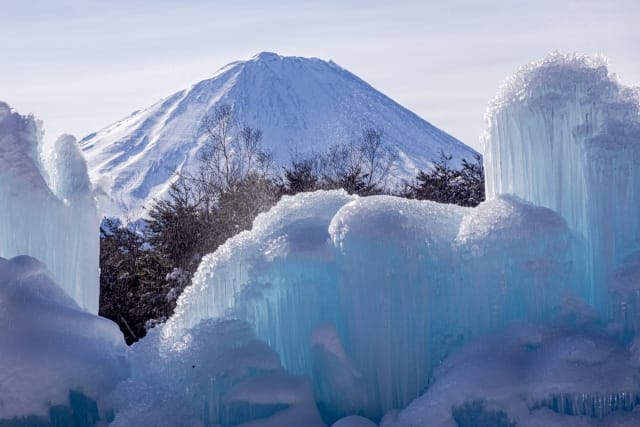
Lake Saiko offers a different atmosphere from Lake Kawaguchiko. Here, the collaboration between frost-covered trees and Mt. Fuji is breathtaking. The contrast between the frost-covered trees with snow flowers on their branches and the silvery Mt. Fuji is breathtakingly beautiful.
The frost-covered trees sparkling like diamond dust in the morning sun make you feel like you've wandered into a fantasy world. The collaboration between the inverted Mt. Fuji reflected in the lake surface and the frost-covered trees is also fantastical, and I often find myself staring in wonder.
The best time to see the frost-covered trees is from late January to mid-February, but this can vary depending on weather conditions. I recommend checking the Lake Saiko Ice Festival schedule when planning your visit.
Lake Yamanakako
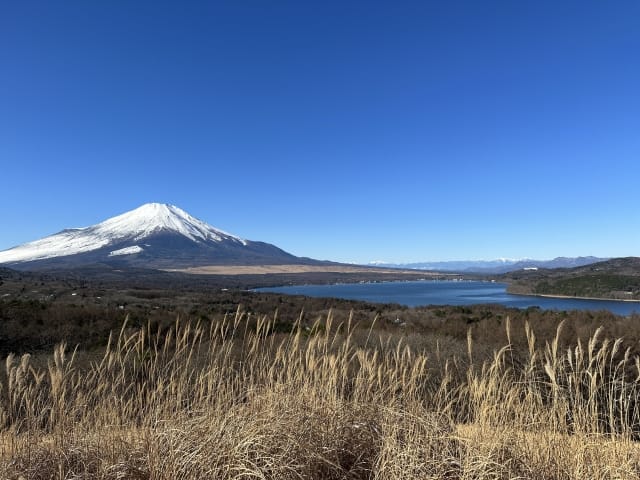
The winter attraction of Lake Yamanakako is, without a doubt, its powerful views of Mt. Fuji. From Panorama-dai on the lake's north shore, you can see Mt. Fuji up close, and I guarantee you'll be overwhelmed by its magnificence.
The scenic beauty of snow-capped Mt. Fuji reflected in the frozen lake surface is beyond words. When I walk along the lakeshore, I feel drawn into Mt. Fuji's world.
At dusk, you'll see a spectacular view where the sunset-bathed Mt. Fuji and the crimson sky create a beautiful gradation reflected in the lake surface. I highly recommend ending your day with a sunset view of Mt. Fuji from Lake Yamanakako.
Lake Motosuko
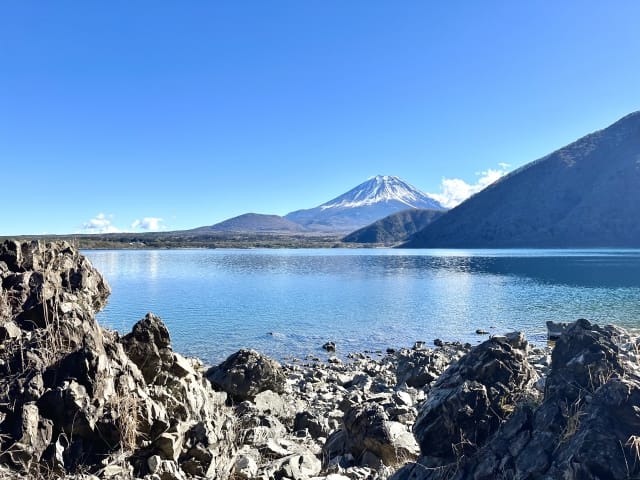
Lake Motosuko is the closest of the Fuji Five Lakes to Mt. Fuji. The highlight of Lake Motosuko in winter is undoubtedly the collaboration between the inverted Mt. Fuji reflected in the lake and the sunset.
At dusk, the silhouettes of Mt. Fuji and the sunset reflected in the lake surface create a scene as beautiful as a traditional ink painting. The contrast between the snow-covered mountains and the lake is also fantastical, often making me sigh in wonder.
I think it's also wonderful to spend special time away from daily life while taking a stroll along the quiet lakeshore. Why not escape the city's noise and immerse yourself in the magnificent nature?
Lake Shojiko
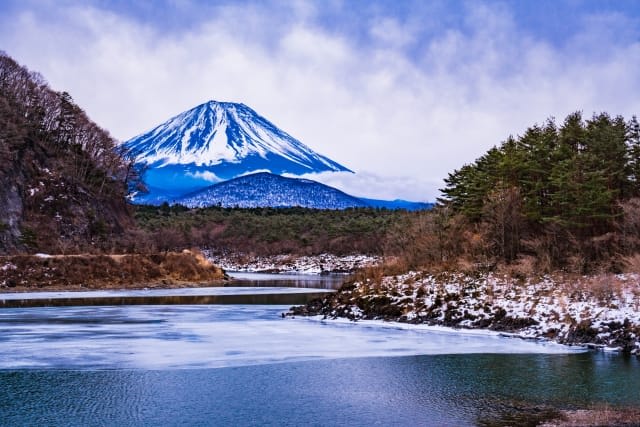
Lake Shojiko is the smallest of the Fuji Five Lakes, but its appeal lies in its mystical atmosphere filled with solemn beauty. In winter, Lake Shojiko shows us the exquisite scenery created by the snow landscape and Mt. Fuji.
The graceful sight of swans floating on the lake surface makes me feel as if I've wandered into an ink painting world.
The highlight of Lake Shojiko is undoubtedly the monochromatic world view of Mt. Fuji and the lake surface. The contrast between the dark Mt. Fuji soaring high and the quietly resting lake is almost mystical. I believe the scenic beauty created by the lava plateau, lake, and Mt. Fuji offers a special experience you can't find anywhere else.
Other Popular Spots
The spectacular viewpoints of Mt. Fuji aren't limited to the five lakes. There are still many spots where you can enjoy the collaboration between Mt. Fuji and natural beauty, such as Oshino Hakkai and Arakurayama Sengen Park.
Oshino Hakkai

Oshino Hakkai is a scenic spot consisting of eight ponds fed by Mt. Fuji's underground springs. The spring water, which never freezes even in winter, is mystical, and I love the beautiful contrast with the snow-covered landscape.
Frost-covered trees line the ponds, creating a fantastical scene with Mt. Fuji in the background. When I listen to the gentle sound of the spring water while immersing myself in the mystical pond scenery, I can forget the daily hustle and bustle.
I believe Oshino Hakkai is a spot where you can encounter not just Mt. Fuji, but also the original landscape of Japan.
Arakurayama Sengen Park
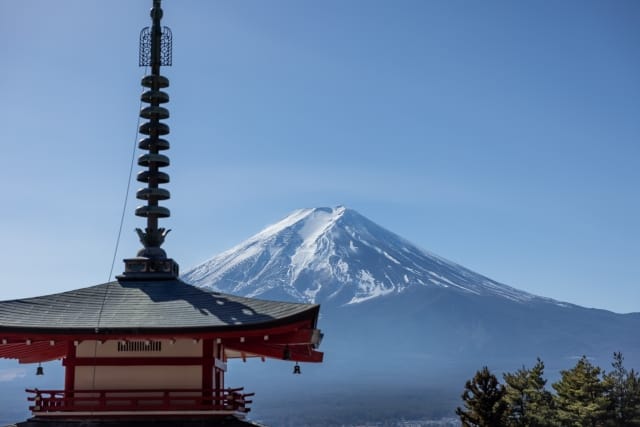
Arakurayama Sengen Park is a popular spot known for its spectacular view of Mt. Fuji from the Chureito Pagoda. The contrast between the five-storied pagoda and snow-capped Mt. Fuji creates a picture-perfect beauty.
While the park is famous as a cherry blossom viewing spot in spring with its rows of cherry trees, I find the winter snow scenery equally special. The snow-covered approach to the shrine, the imposing five-storied pagoda, and Mt. Fuji looming behind - this scenic beauty makes me feel the traditional Japanese atmosphere.
You can use the ropeway to reach the summit without walking through snowy paths, making it perfect for enjoying Mt. Fuji views. Since it's colder at the summit due to the elevation, I recommend preparing warm clothing before visiting.
While the tourist spots I've introduced so far are my top recommendations, they're located in different areas, which might make it challenging to plan your own itinerary. That's why I recommend joining the "Mt. Fuji Full-day Nature Guided Tour with a Private Chartered Car," led by guides who know the Mt. Fuji area inside and out.
The tour includes round-trip transportation from Tokyo and takes you to all the must-see spots around Mt. Fuji. Some routes even include visits to Oshino Hakkai and Arakurayama Sengen Park!
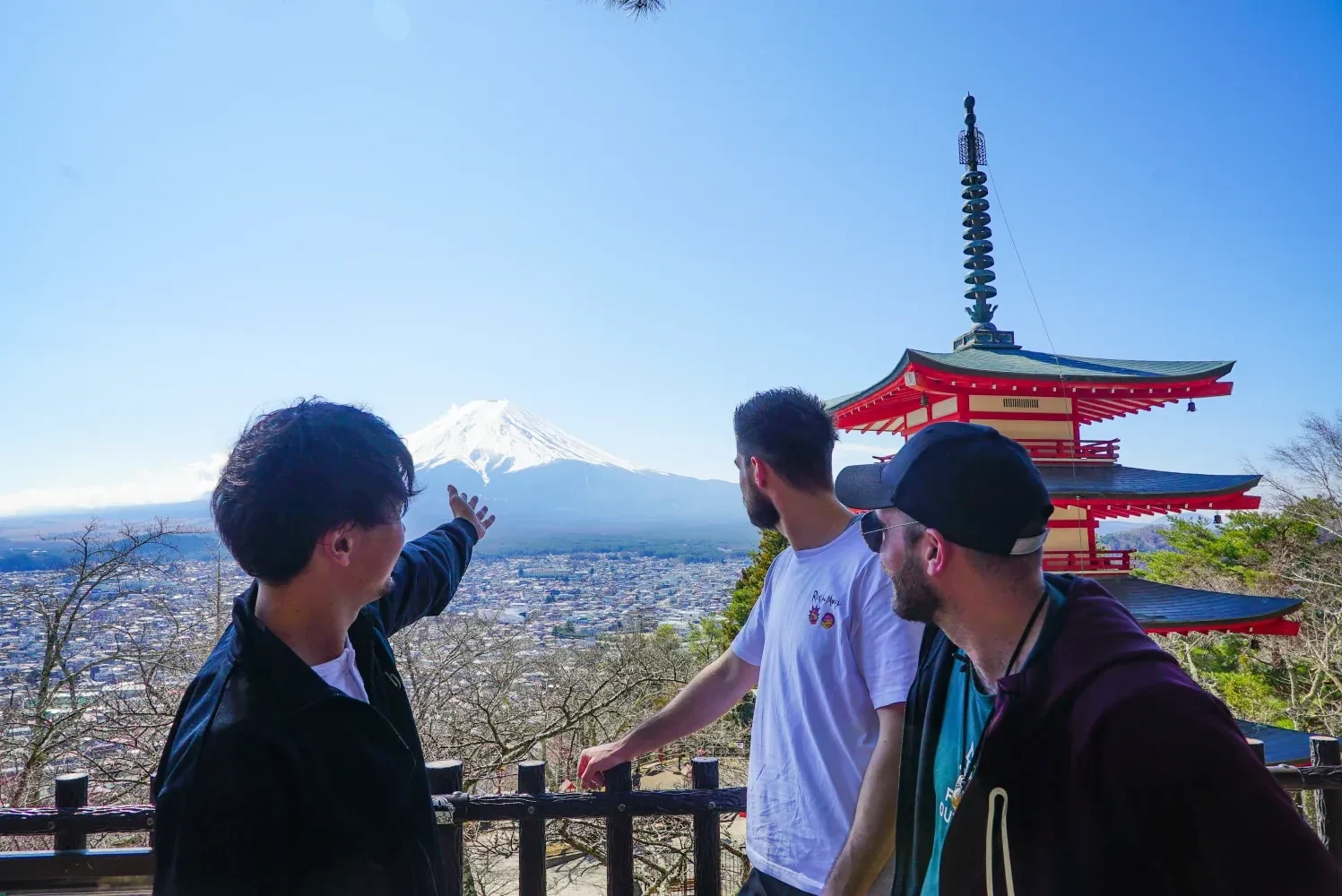
Winter Events and Activities Around the Fuji Five Lakes
In the Fuji Five Lakes area during winter, various events and activities are held with Mt. Fuji as a backdrop.
The area is packed with winter-specific attractions, from fantastic illuminations to warming cuisine and winter sports. Let me introduce some particularly recommended events and activities.
Let's Participate in Winter-Specific Events
Lake Kawaguchiko Winter Fireworks
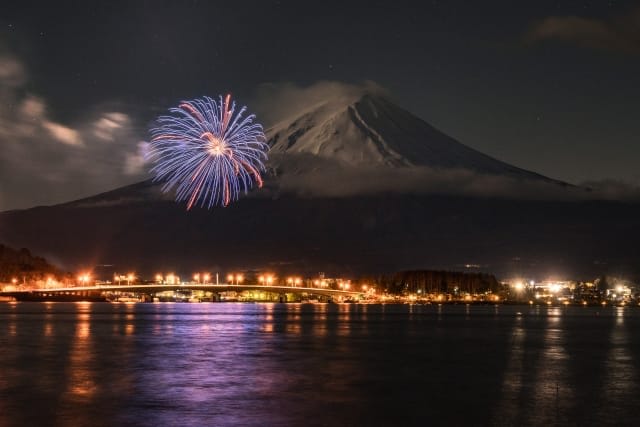
The "Lake Kawaguchiko Winter Fireworks" is a winter tradition at Lake Kawaguchiko. I find the fireworks show that colors the night sky over the snow-covered lake fantastically beautiful.
The combination of aerial fireworks and their reflections on the lake surface is overwhelmingly impressive. At the venue along Lake Kawaguchiko's shore, you can enjoy warm food from street vendors. I'm sure it will create the best memories as you warm up your cold body while watching the romantic fireworks show.
Typically held on weekends from mid-January to late February. For 2025, it's scheduled from January 25th to February 23rd, so I recommend planning your visit accordingly.
Website: https://fujisan.ne.jp/en/pages/403/
Lake Yamanakako Ice Candle Festival
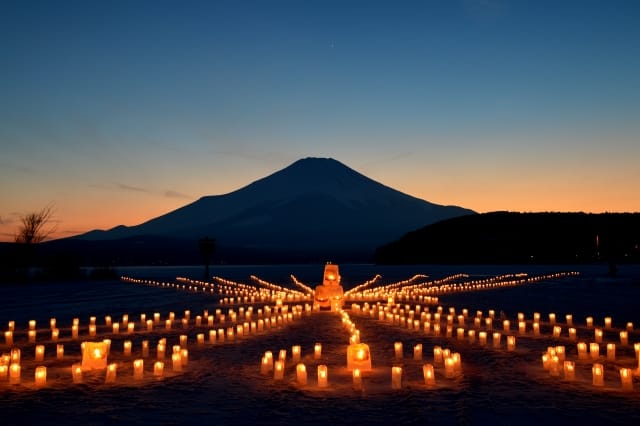
The "Lake Yamanakako Ice Candle Festival" is a winter tradition that decorates the lakeshore with fantastical candlelight.
From dusk, hundreds of ice candles are lit along the lakeshore, creating a fantastical scene with Mt. Fuji in the background.
Fireworks are also launched at the venue, enhancing the romantic atmosphere. I especially love the warm street food using local ingredients that warms you up from the core.
The 2025 event is scheduled for February 23rd. I encourage you to come and witness the fantastical lights illuminating winter Lake Yamanakako with your own eyes.
Website: https://lake-yamanakako.com/event/10384
Lake Saiko Ice Festival

The "Lake Saiko Ice Festival" is a major event where you can enjoy the collaboration between Mt. Fuji and frost-covered trees.
This festival is held at Lake Saiko Wild Bird Forest Park from early to mid-February each year. During the day, you can see ice sculptures up close, and at night, a fantastical world of illuminated frost-covered trees unfolds.
While the 2025 schedule is still undetermined, I recommend checking the official website and making sure to visit.
Website: https://fujisan.ne.jp/en/pages/405/
Let's Enjoy Snow Activities
Fujiten Snow Resort
Source: Google Map
"Fujiten Snow Resort" at the foot of Mt. Fuji is a ski resort that beginners to advanced skiers can enjoy.
I recommend it for ski beginners and families because it mainly features gentle slopes. I appreciate that it's equipped with a kids' park and sledding-only slopes, making it safe for families with children. It's also convenient that you can rent ski and snowboard equipment, so you can visit empty-handed.
I'm sure enjoying winter sports while viewing Mt. Fuji will be an extraordinary experience.
Website: https://www.fujiten.net/
Winter Cuisine Around Mt. Fuji
Around Mt. Fuji in winter, you can enjoy many local dishes that warm you to the core. Yamanashi Prefecture particularly offers plenty of hot pot dishes that I crave during the cold winter. Here, I'll introduce winter specialties unique to the Mt. Fuji foothills.
Hoto
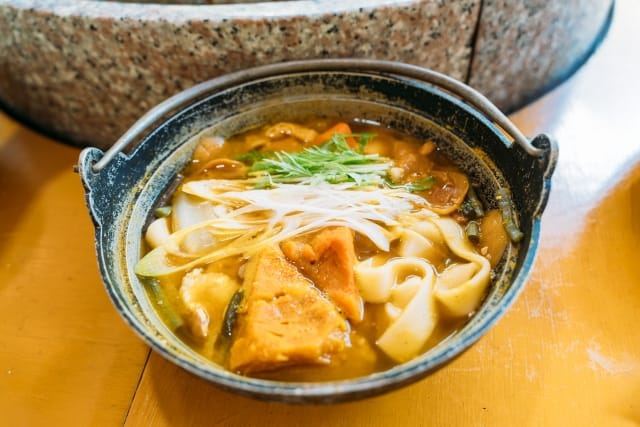
"Hoto" is one of Yamanashi Prefecture's representative local dishes. It's a nutritious dish where plenty of ingredients are simmered in a warm miso-flavored pot.
The main ingredients in the pot are vegetables like pumpkin, Chinese cabbage, carrots, daikon radish, and green onions. What makes it special is the addition of thick, flat noodles with a firm texture. I love how the sweetness of the vegetables perfectly matches the chewy texture of the noodles, making you want to keep eating more.
The gentle miso flavor warms you from the inside, making it perfect for cold winter days. I recommend it for lunch when you're feeling hungry or after skiing, as it's packed with plenty of ingredients and very filling.
Yoshida Udon

"Yoshida Udon" is a local specialty of Fujiyoshida City at the foot of Mt. Fuji. I can tell you it's a local favorite in Yamanashi, characterized by its chewy noodles and light broth.
The noodles, made with local flour, are distinctively thick with a chewy texture. I find the rich flavor of wheat perfectly matches the flavorful broth made with Mt. Fuji's spring water.
While plain udon is delicious, I love that there are plenty of variations like meat udon, mountain yam udon, and curry udon. The hot broth with firm noodles is especially comforting in cold winter.
There are many famous Yoshida Udon restaurants throughout Fujiyoshida City, so I suggest exploring to find your favorite bowl. When you get hungry from walking around, warm yourself up from the core with a hot bowl of Yoshida Udon.
Frequently Asked Questions About Mt. Fuji in Winter
Preparation is essential for sightseeing in cold weather. Around snow-covered Mt. Fuji in particular, many people are unsure about what clothes to wear and items to bring. Here, I'll answer common questions from foreign travelers.
Can I Climb Mt. Fuji in Winter?
Since Mt. Fuji's mountain huts are closed during winter, climbing via normal routes to the summit is basically not possible.
However, if you're an experienced climber, I can tell you it's possible to hike in the lower mountain areas up to around the 5th station with your own snowshoes and crampons. If you understand the risks, you can challenge yourself up to the tree line.
That said, Mt. Fuji in winter is colder than you might imagine, with dangers like sudden weather changes and blizzards. I recommend not pushing yourself and treating it as a scenic hiking experience. For beginners, I suggest attempting the climb during the milder seasons from spring to autumn, always prioritizing safety.
What Should I Wear in Winter?
The Fuji Five Lakes area is much colder than Tokyo, with average temperatures around -5°C (23°F) on New Year's Day. I often see temperatures below freezing even during the day.
For sightseeing during the severe cold season, I always recommend a down jacket or similar warm outerwear as essential. It's effective to adjust layers with sweaters and fleece, and wear thin thermal underwear like HEATTECH. Don't forget accessories like gloves, scarves, and knit hats.
I recommend waterproof boots that are easy to walk in and resistant to getting wet or dirty. For preventing falls, I suggest shoes with low heels are better. Since there's a big temperature difference between indoors and outdoors, I advise dressing in layers that you can easily adjust.
How Much Budget Should I Plan for Sightseeing?
For winter sightseeing in the Mt. Fuji area, I suggest a budget of 50,000 to 70,000 yen for a 2-night, 3-day trip would allow you to enjoy most activities.
The highway bus between Tokyo and Lake Kawaguchiko costs around 8,000 yen round trip. For accommodation, a business hotel class at around 10,000 yen per night is sufficient. Activities average around 5,000 yen each.
For meals, I recommend budgeting 3,000-5,000 yen per day. You can manage without spending too much by having a set meal or udon for lunch at around 1,000 yen, and local cuisine for dinner at around 3,000 yen.
How did you like the winter attractions of Mt. Fuji?
As a Japanese person, I believe Mt. Fuji dressed in snow is Japan's most spectacular view. As long as you prepare well for the cold, I'm confident you'll encounter incredibly mystical scenery. Why not take a break from the city's bustle and enjoy winter Mt. Fuji at a relaxed pace while being healed by the power of great nature?
I hope you'll use this article as a reference when planning your winter Mt. Fuji area sightseeing.
